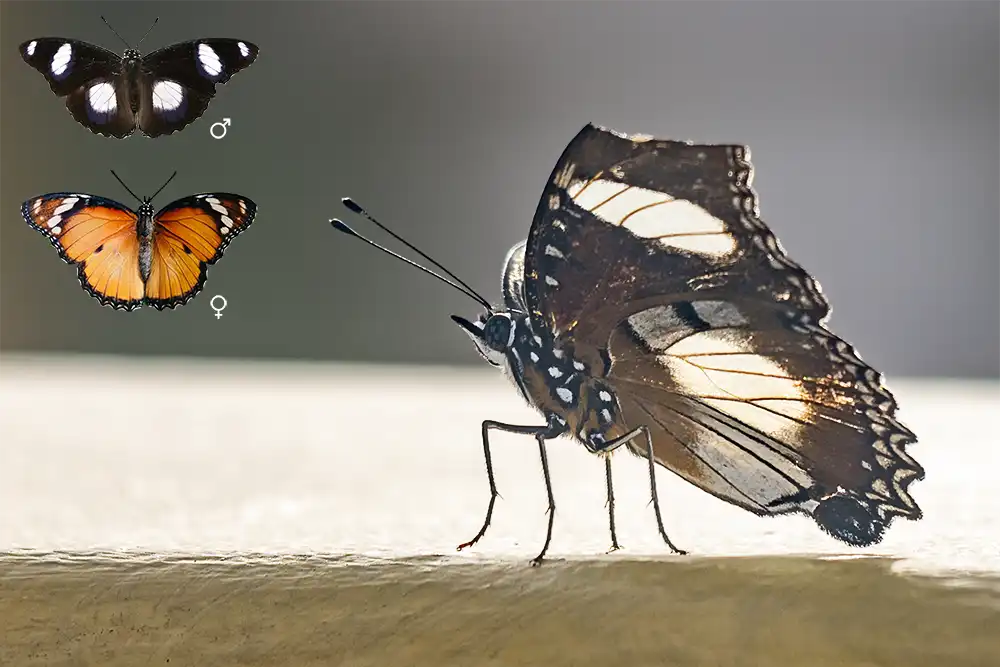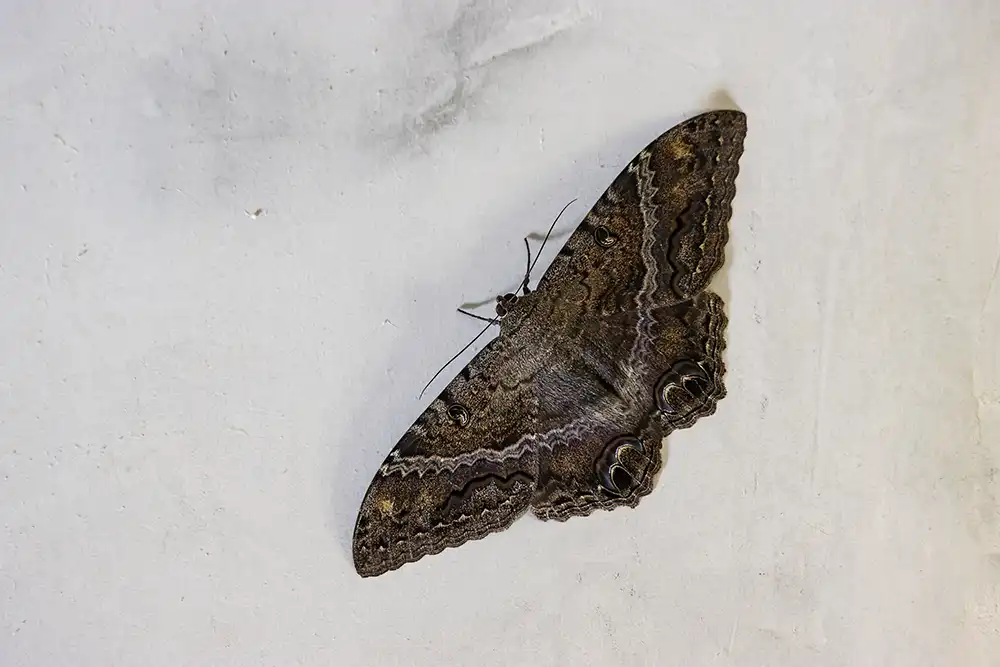During the rainy season, and even in the months that follow, Bonaire is teeming with colorful butterflies. You can admire them in flower-filled garden. During a hike in nature, you’ll also encounter beautiful butterflies. In this blog, we’ll introduce seven common butterflies, ranging from large to small. We’ll conclude with the island’s largest butterfly, the Black Witch Moth. This rare appearance frightens some residents of Bonaire!
During our tours, we pay close attention to the colorful nature of Bonaire. We certainly take the time to appreciate the beautiful birds and butterflies we come across.
Onderwerpen
- 1 1. The Monarch Butterfly (Danaus plexippus)
- 2 2. The Gulf Fritillary (Agraulis vanillae)
- 3 3. The Danaid eggfly (Hypolimnas misippus)
- 4 4. The Cloudless Sulphur (Phoebis sennae)
- 5 5. The Guayacan Sulphur (Kricogonia lyside)
- 6 6. The Fiery Skipper (Hylephila phyleus)
- 7 7. The Hanno Blue (Hemiargus Hanno)
- 8 The Black Witch (Ascalapha odorata)
- 9 A Tour with HopiBonaire
- 10 Read more?

1. The Monarch Butterfly (Danaus plexippus)

You can’t miss the Monarch Butterfly (Monarka in Papiamentu) if you stay on Bonaire during the winter months. This nearly 10-centimeter (4-inch) orange butterfly is abundant on the island, even in the heart of Kralendijk. The monarch butterfly is world-famous for its unique migration behavior. In the photo blog dedicated to this photogenic butterfly, you’ll learn everything about it, including the beautiful caterpillar and the stunning chrysalis.
2. The Gulf Fritillary (Agraulis vanillae)

The Gulf Fritillary (Barbulètè Oraño in Papiamentu) is often spotted near passionflowers. This orange butterfly, prevalent on Bonaire, is also referred to as the Passion Butterfly. The females grow to about 7 centimeters (3 inch), while the males are slightly smaller.
These butterflies have an interesting defense mechanism against predators. If caught by a bird or even feeling threatened, the butterfly releases a strongly scented substance. Birds prefer to leave this stinker alone!
3. The Danaid eggfly (Hypolimnas misippus)

The appearance of the male and female Danaid eggfly (barbulètè di seru in Papiamentu) differs significantly. If you see a black butterfly with white spots fluttering on Bonaire, it’s a male Danaid eggfly. On the underside, the butterfly is orange. The female is also orange, with a black edge and white details. These butterflies are about 7 centimeters in size.
These butterflies are not only found in South and North America but also in Africa, Asia, and Australia! They are incredibly strong flyers, having crossed several oceans. On Bonaire, they are mainly seen in the hills, such as on Seru Largu and Brandaris. The best chance to spot them is in the early months of the rainy season.
4. The Cloudless Sulphur (Phoebis sennae)

The Cloudless Sulphur (Barbulètè Hel in Papiamentu) is frequently observed. This remarkably yellow butterfly enjoys visiting the gardens of Bonaire because it is particularly fond of Bougainvillea, lantana, and Hibiscus flowers.
The Sulphur grows to about 6 centimeters (2.5 inch) and is distinguished from other yellow butterflies by brown spots on its wings. The female also has a dark edge along the upper wings.
5. The Guayacan Sulphur (Kricogonia lyside)

Moving on to the smaller butterflies, the Guayacan Sulphur (Hel di Wayaka in Papiamentu) measures only 4.5 centimeters (2 inches). This white butterfly with a striking yellow wing base is also prevalent in the gardens of Bonaire. Even in the midst of the dry season when many butterflies have disappeared, these flutter about merrily!
6. The Fiery Skipper (Hylephila phyleus)

The Fiery Skipper, (Kabes Diki Vlandam in Papiamentu), is a small orange-brown butterfly. With a size of only 2.5 centimeters (1 inch), it can easily go unnoticed. This Skipper holds its wings in a distinctly triangular shape, folding its hindwings flat. It is suspected that the butterfly adopts this posture to better absorb sunlight.
7. The Hanno Blue (Hemiargus Hanno)

The Hanno Blue (Blou Komun in Papiamentu) also is a skipper. It closely resembles the European Common Blue. This blue butterfly is only 2 centimeters (less than 1 inch) in size and belongs to the smallest butterflies on Bonaire. On the underside, the Hanno Blue displays a beautiful pattern of spots and eyespots. Like the Guayacan Sulphur, you can encounter this butterfly even in the driest months.

The Black Witch (Ascalapha odorata)

The nearly 15 centimeters (6 inch) large dark brown to black Black Witch (Barbulètè di Morto in Papiamentu) is an impressive sight. Unlike the previously mentioned butterflies, you won’t encounter this moth as easily. Typically, the Black Witch is seen on Bonaire only when the first rains of the rainy season have just fallen. The caterpillar feeds on the leaves of the candle bush, a local shrub with beautiful yellow flowers.
The Black Witch is mainly seen in houses and on porches on the island. At night, they are attracted to the lights in the houses. During the day, the moth seeks a shady spot to spend the day. Unfortunately, with its appearance, this moth frightens the residents of many houses. The story goes that the Black Witch announces the impending death of one of the residents. To avert this fate, this beautiful butterfly is all too often killed!
In other cultures, the Black Witch is welcomed with love. In Hawaii, it is believed that the moth is the soul of a deceased loved one coming to say goodbye. In the Bahamas, the moth supposedly heralds prosperity. In Texas, people rush to buy a lottery ticket when a Black Witch takes position above the door. Supposedly, you would win the lottery for sure… We at HopiBonaire also associate the Black Witch with prosperity. What luck if such a beautiful creature decides to spend a day in your house. And no, we are still very much alive!
A Tour with HopiBonaire

Are you eager to explore the most remote and beautiful places in Bonaire? During a tour with HopiBonaire, you’re away from the crowds! Since you’re only traveling with your own party, a tour with us is a personal experience. The guide is flexible and takes the time you need!
All tours can be tailored to your preferences, and we also offer fully customized tours. Are you interested in such an adventure?
Read more?
Are you a butterfly enthusiast? Be sure to read our colorful photo blog about the extraordinary Transformation of the Monarch Butterfly. In addition to this colorful flutterer, there is also a blog about the Colorful Birds on Bonaire and the Flamingos of Bonaire. If you want to learn more about the unique nature of Bonaire, take a look at our page about Nature in Bonaire, with blogs about The Lizards, The Wild Mammals and The Sea Turtles of Bonaire. Do you really want to experience nature? Go Hiking on Bonaire! Explore all our blogs on our organized Blog page. |

